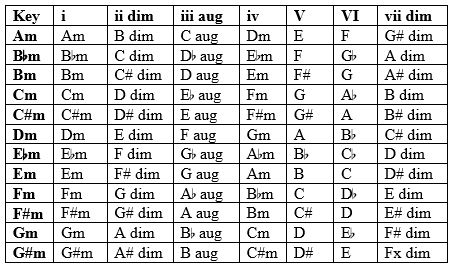Contemporary Music Theory
Pursuing Excellence
Personal Development
Leadership Principles
Administrative Skills
Diatonic Chords - Minor Keys

The chords which naturally occur in a minor key depend on whether the chords are based on the harmonic minor scale or the natural minor (also called the pure minor or Aeolian mode). If they are based on the natural minor the pattern of diatonic chords is as follows in the key of A minor (the chords are built from the root note up):
Which works out to this pattern for all minor keys based on the natural minor scale:
So the diatonic chords in the various (natural) minor keys are as follows:
If based on the harmonic minor the chord pattern for A minor is as follows:
Which works out to this pattern for all minor keys based on the harmonic minor scale:
So the diatonic chords in the various (harmonic) minor keys are as follows:
It is not uncommon for songs in minor keys to use chords based on both of these minors. For instance, the progression Am - G - F - E, makes use of the G chord from the natural minor and the E chord from the harmonic minor scale.
For more information on contemporary music theory, buy Contemporary Music Theory. (This link will take you to Createspace.com, a subsidiary of Amazon.)
Understanding Scales | Understanding Chord Structure | Understanding Diatonic Chords | Understanding Minor Scales | Diatonic Chords in Minor Keys | Scale Degree Names | Chord Substitution - Extended Chords | Chord Substitution - Overlapping Chords | Improvisation - Arpeggios | Improvisation - Major Scales | Improvisation - Pentatonic Scales | Improvisation - Blues Scales






